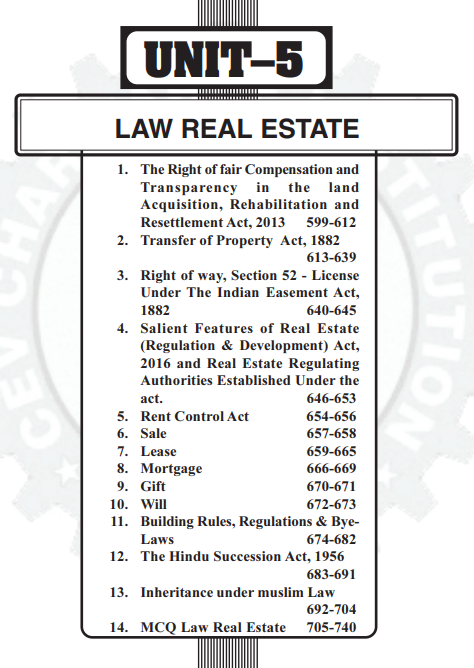LAWS RELATED TO LAND & BUILDINGS
UNIT-5 CHAPTER 1 TO 7
COMPLETE E-BOOK
UNIT-5

CHAPTER-1
THE RIGHT TO FAIR COMPENSATION AND TRANSPARENCY IN THE LAND ACQUISITION, REHABILITATION AND RESETTLEMENT ACT, 2013 (RFCTLARR ACT 2013)
The Right to Fair Compensation and Transparency in the Land Acquisition, Rehabilitation and Resettlement Act, 2013 (RFCTLARR Act 2013) Rehabilitation and resettlement award (Chapter V) Acquisition of part of house or building (5-9)
It states right to acquire private property for public purpose. The earlier Land Acquisition Act 1894 did not have any concept of consultation, all acquisition was forced. It had provisions of an urgency clause but it was ……………… READ MORE
CHAPTER-2
TRANSFER OF PROPERTY ACT,1882
INTRODUCTION
Transfer of property Act Came into force 01.07.1882. This Act applies for both immovable and movable property and also to tangible and intangible properties. According to the Transfer of Property Act 1882, “Transfer of Property“ means an act by which a person conveys property to one or more persons. The act of transfer may be done in the present or for the future. The person may include an individual, company or association or body of individuals, and any kind of property may be transferred, including the transfer of immovable property.
“Transfer of Property” means an act by which a person conveys property to one or more persons. The act of transfer may be done in the present or for the future. The person may include an individual, company or association or body of ……………… READ MORE
CHAPTER-3
RIGHT OF WAY, SECTION 52 – LICENSE UNDER THE INDIAN EASEMENT ACT, 1882.
“EASEMENT” defined. -An easement is a right which the owner or occupier of certain land possesses, as such, for the beneficial enjoyment of that land, to do and continue to do something, or to prevent and continue to prevent something being done, in or upon, or in respect of, certain other land not his own.
An easement is the right to use the real property of another without possessing it. DOMINANT AND SERVIENT HERITAGES AND OWNERS.—The land for the beneficial enjoyment of which the right exists is called the dominant heritage, and the owner or occupier thereof the dominant owner; the land on which the liability is imposed is called the servient heritage, and the owner or occupier thereof the servient owner.
Explanation.—In the first and second clauses of this section, the expression “land” includes also things permanently attached to the earth; the expression “beneficial enjoyment” includes also possible convenience, remote advantage, and even a mere amenity; and the expression “to do something” includes removal and appropriation by the dominant owner, for the beneficial enjoyment of the dominant ……………… READ MORE
CHAPTER-4
SALIENT FEATURES OF REAL ESTATE (REGULATION & DEVELOPMENT) ACT, 2016, AND REAL ESTATE REGULATING AUTHORITIES ESTABLISHED UNDER THE ACT.
The Real Estate (Regulation and Development) Act, 2016 is an Act of the Parliament of India which seeks to protect home-buyers as well as help boost investments in the real estate industry. The bill was passed by the Rajya Sabha on 10th March, 2016 and by the Lok Sabha on 15 March 2016. The Act came into force from 1 May 2016 with 69 of 92 sections notified. The Central and state governments are liable to notify the Rules under the Act within a statutory period of six months. Real estate regulatory authority (RERA) is the governing authority. The law is not Retrospective Preamble: RE(R&D)ACT 2016
To establish RERAs in Each State to: –
Regulate and promote Real Estate Sector, Ensure Sale in efficient and Transparent Manner, To Protect Consumer, Adjudicating mechanism for speedy Dispute Redressal, To establish Appellate Tribunal
SALIENT FEATURES:
Establishes the State Real Estate Regulatory Authority for that particular state as the government body to be approached for redressal of grievances against any builder. Vests authority on the real estate regulator to govern both residential and commercial real estate transactions. ……………… READ MORE
CHAPTER-5
RENT CONTROL ACT
A central Rent Control Act was passed by the legislature in 1948. It regulates the rules of letting out a property and ensures that neither the landlords nor the tenants’ rights are exploited by the other. It should also be noted that currently, each state has its own Rent Control Act, though largely similar to each other, they carry some minor differences.
Due to the 1948 Act being extremely stringent and pro-tenant, the real estate market has had difficulty in growing in some areas. There are some properties that have been let out that are still paying the same amount of rent since 1948, disregarding inflation and increased property valuations.
In 1992 the Central Government tried to bring about amendments to the Act via a proposed model to ensure that the property is not devalued. Unfortunately, the changes were opposed by the sitting tenants and therefore failed to take effect. Under the Indian Constitution, the provision of housing ……………… READ MORE
CHAPTER-6
SALE
A sale is a transaction between two or more parties in which the buyer receives tangible or intangible goods, services, or assets in exchange for money. In some cases, other assets are paid to a seller.
An agreement by which one of the contracting parties, called the seller, gives a thing and passes the title to it, in exchange for a certain price in current money, to the other party, who is called the buyer or purchaser, who, on his part, agrees to pay such price.
This contract differs from a barter or exchange in this, that in the latter the price or consideration, instead of being paid in money, is paid in goods or merchandise, susceptible of a valuation. It differs from accord and satisfaction because in that contract, the thing is given for the purpose ……………… READ MORE
CHAPTER-7
LEASE
LEASE DEFINITION
As per Section 105 of the Transfer of Property act Lease is defined as:-
A lease of immovable property is a transfer of a right to enjoy such property, made for a certain time, express or implied, or in perpetuity, in consideration of a price paid or promised, or of money, a share of crops, service or any other thing of value, to be rendered periodically or on specified occasions to the transferor by the transferee, who accepts the transfer on such terms. Lessor, lessee, premium and rent defined.—The transferor is called the lessor, the transferee is called the lessee, the price is called the premium, and the money, share, service, or another thing to be so rendered is called the rent. Therefore, A lease of immovable property is a transfer of a right to enjoy such property made ……………… READ MORE
CLICK THE BELOW LINK TO READ THE COMPLETE CONTENTS
KIND ATTENTION
We are going to close all what’s groups of CEV soon due to difficulties in posting information or message in more than 5 groups of CEV at a time.
All future posts of empanelment notices & professional importance will be shared on
1. https://t.me/+dbHNkNO22xsyYTY1
2. www.valuerworld.com
3. The Twitter handle of CEV India
https://twitter.com/cevindia?t=XbqlvnwUVz1G3uPgs749ww&s=09
after closing the groups.
All members of these groups are requested to register themselves at the following link immediately for Getting all related timely updates…..


